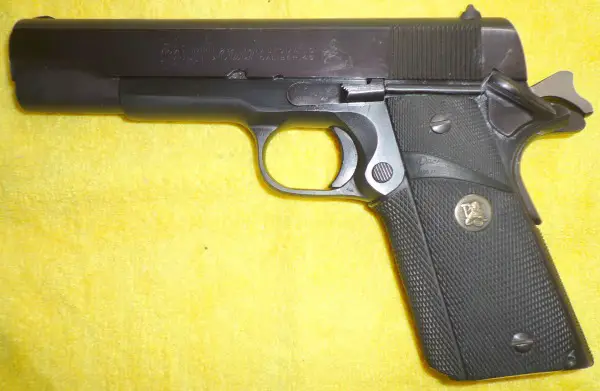|
Colt Pre-Series '70 Government Model .45 By David Tong  After bouncing around with most of the "latest and greatest" service pistols for over a decade, I realized that I needed to return to my shooting roots, my essential truth, as it were. While there is little question that the lightweight, striker-fired pistol remains in ascendancy, to me there is still a place for the permanence of machined forged steel, a crisp single action trigger, manual safety and hammer-fired actuation. Nowhere is this better embodied than John Browning's classic Model 1911. While I have delved into pistols from Kimber and Metro Arms, the notion of finding another original, commercial pattern, Colt Government Model was in the back of my mind for about 20 years. The ideal specimen would have no modifications and would fully display the state of Colt manufacturing processes during that era. When I acquired an example made in the late 1960s, I knew it was THE ONE. They are not exactly thick on the ground at your local gun shop, by the way. Colt Government Model Basic Specifications
First, the good. Pistols made by Hartford at the time had major components entirely machined from forgings. There were no investment castings, MIM, or plastics. All the exterior edges, save one, are properly beveled or chamfered to remove the potential for cutting holster leather, or skin. These days, the Colt Custom Shop charges approximately $175 to do this, when it used to be a matter of course until the early 1990s. The barrel bushing is of the standard solid type, not the later spring steel collet bushing that proved so problematic for the Series '70, due to breakages. The barrel and slide locking lugs are also properly chamfered for smooth operation and to reduce the potential for battering. Its barrel feed ramp shows a transitional design, compared to the Series '70 and later pistols. It incorporates what appears to be an original G.I. style normal ramp, along with smaller secondary ones that extend only to 9 and 3 o'clock. In contrast, Series '70 and later pistols use ramp extensions that extend all the way to 10 and 2, while the Colt XSE Rail Gun I reviewed on these pages had yet another design in the continuing evolution of the pistol. The pistol has the usual fine Colt single action trigger pull. The trigger blade and its stirrup were fitted with some care, as it exhibits none of the up/down or side-to-side slop of the Series '70 pistols. The pull weight is just a tick over four pounds and crisp. The very short reset is audible and tactile. The 1911 has always set the standard for full-sized service pistols in this regard and it was unsurprising this example, made nearly fifty years ago, passed muster. The grip screw bushings were properly staked into place on the receiver. This may seem a small matter, but if someone torques the screws into them with vigor, attempting to remove the grips may result in turning the bushing from the frame, rather than the grip screw from the bushing. Series '70 and later pistols dispensed with this nicety. The finish is the standard blue, soft sheen broken by the curved surfaces in the usual sand-blasted matting, not the higher gloss and larger roll-markings of the Series '70. The frame and slide rails showed no sign of "chattering," or machine marks. Operation is free-running and smooth. Now, for the bad. First, the rear of the frame, right where you would grip the pistol over the grip safety, had its otherwise beveled tangs protruding OVER the depressed grip safety. Interior edges were left rather sharp. As I did not wish to re-contour the concave cuts and refinish the entire frame, I merely beveled the inside edges with a small half-round Swiss file and fine emery paper. I then applied some Tetra Gun cold blue touch-up. While the grip safety's convex surface remains lower than the frame tangs, at least they will no longer draw blood after much shooting. Lest one think this rather strange lack of attention to detail is unusual, my dad's 1975 Gold Cup has the same problem. This is somewhat inexplicable. The second demerit, also shared with that Gold Cup, is the muzzle crown. Evidently, after the original machined crown was performed, an over zealous person decided it was better, somehow, to polish the crown with a buffing wheel. The only two places where the previous owner(s) changed this pistol were the grips and a flat mainspring housing. These can be replaced at some effort and expense. Since the pistol otherwise rates a solid 98% condition, I will not quibble. I have typically used Pachmayr Signature steel lined rubber grips that wrap around the otherwise smooth front strap and have done so here. They offer a more temperature neutral feel, non-slip surface and protection for your hands in the rare event of an over-pressure cartridge or out of battery firing and the subsequent venting of gas down the magazine well. I look forward to sending some rounds downrange soon. It is good to be back "home." |